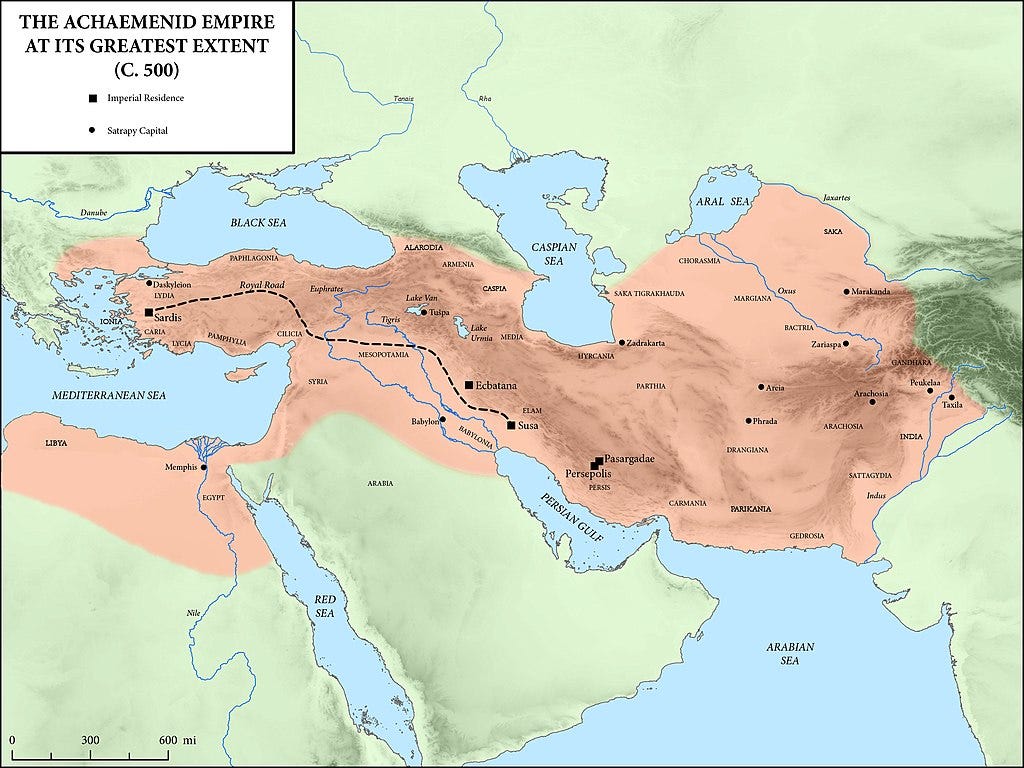Welcome to
. This post is part of our Cartography of Networks series. For the full map of posts, see here.
Sweet to ride forth at evening from the wells When shadows pass gigantic on the sand, And softly through the silence beat the bells Along the Golden Road to Samarkand.
— James Elroy Flecker
The Silk Road is perhaps the most well-known trade route in history, but its name is actually a bit of a misnomer. Rather than a single passage, the famed ‘road’ was instead a network of paths that crisscrossed Eurasia, connecting empires, kingdoms, and peoples at opposite ends of the Old World.
The road takes its name, which was coined only in the 19th century, from the highly-prized Chinese exports of silk, but textiles were far from the only goods transported along its dusty paths. Precious metals, spices, paper, furs, wine, fruit, coinage, livestock, weapons, beliefs, inventions, and people flowed back and forth from one end of Eurasia to another. We are accustomed to thinking of global trade as a modern phenomenon, but in fact our capacity for long distance commerce has deep roots in antiquity.
Most of us have some degree of knowledge about the kingdoms and empires at either end of the Silk Road — Europe to the west, and China to the east — but what of the vast expanse in between? Who lived there? Who did the trading? How were such a vast array of goods exchanged over such long distances?
In this post, we will answer these questions and more, but first let’s start at the very beginning.
Origins of a Western Road
Mesopotamia gave rise to the first multi-city civilisations, creating the conditions for goods to flow back and forth between cities like Ur, Uruk, and Babylon. But it wasn’t until the rise of the Achaemenid Persian Empire in the 6th century BC that truly long-distance trade first began.
As Herodotus describes in his Histories, “The Persians are greatly inclined to foreign customs.” Their cultural tolerance and willingness to adopt ideas and practices from their vanquished enemies allowed the Persians to quickly carve out an empire that stretched from Asia Minor to India. But it had another advantage too: it enabled them to build up a sophisticated administrative system and a complex economy within its vast multi-ethnic empire. To further facilitate trade — and to capitalise on the ensuing tax bonanza — the Persians built what was perhaps the most extensive road network hitherto seen anywhere in the world. It included the famous Royal Road, which connected Susa in the Iranian heartlands to Sardis at the western edge of Anatolia, enabling travel across more than 1600 miles in a single week. Stories of the fabulous wealth of the Persian Empire soon spread, showing up in Greek epic poems and plays.

Perhaps inspired by these stories of an opulent East, a young Macedonian turned the Persians’ famous road against them when he used the highway to lead his armies deep into their empire, where he spectacularly defeated a far superior force at the Battle of Gaugamela (now Erbil, in Iraqi Kurdistan). Alexander the Great went on to conquer the entire Persian Empire and then some, running up to the edge of the Indian subcontinent, and northwards deep into Central Asia.
Though he died mysteriously at the young age of 32 in Babylon, Alexander left a lasting cultural legacy, if not a political one. Upon his death his vast empire shattered into competing kingdoms as his generals and bodyguards fought among themselves. In the East, a Macedonian officer named Seleucus emerged victorious, carving out a territory from the Tigris to the Indus River. His dynasty, the Seleucids, ruled the region for almost 300 years, and oversaw an extraordinary process of cultural exchange.
Though perhaps not ‘true Greeks’ themselves, the Macedonians had brought Hellenic culture with them on their conquests through the Near East. Even after Alexander’s death, Greeks continued pouring eastwards, and a process of Hellenisation took place everywhere from Egypt to Bactria. Greek was the language of the Seleucid administration and thus was used for affairs of the state like treaties and tax receipts. The Olympian gods got as far as India (there are statues of Apollo in Gundhara Valley), and Greek inscriptions can be found over altars, monuments, and tombs, all over southwestern Asia. Maxims from Delphi can still be read today where they were carved into the rock in Ai-Khanoum in northern Afghanistan, while the influence of Homer is evident in Sanskrit epics like the Rāmāyana. Even the nomads on the wild steppes to the north felt the Hellenic influence, where luxury goods were exchanged for horses.
But, the Greeks weren’t the only ones looking to trade with the steppes. To the east of the nomads, an old empire was newly resurgent, and beginning to flex its muscles once again.





